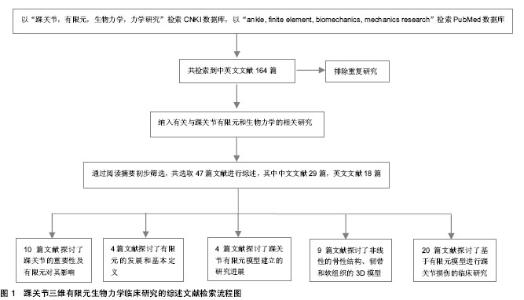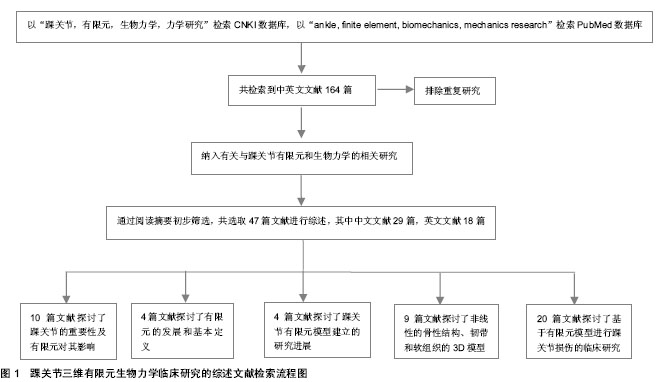| [1] Chevalier TL, Hodgins H, Chockalingam N. Plantar pressure measurements using an in-shoe system and a pressure platform: a comparison.Gait Posture. 2010;31(3):397-399.
[2] Keijsers NL, Stolwijk NM, Pataky TC. Linear dependence of peak, mean,and pressure time integral values in plantar pressure images. Gait Posture. 2010;31(1):140-142.
[3] Sowrnianarayanan S, Chandrasekaran A, Krishna R. Kumar;Finite element analysis of a subtroehanteric fractured femur with dynamic hip screw,dynamic condylar screw,and proximal femur nail implants a comparative study. Proe Inst Meeh Eng H. 2008;222(1):117-127.
[4] 李光宪,季永东,郭延章.踝关节损伤后不稳定的手术重建[J].中国修复重建外科杂志,2003,17(6):459-460.
[5] 王旭,马昕,陶凯,等.足踝有限元模型的建立与初步临床应用[J].中国生物医学工程学报,2008,27(2):287-292.
[6] 赵俊奇,邱莉.踝关节骨折伴下胫腓关节分离的治疗[J].中国实用医药,2009,4(10):70-71.
[7] 李立,谭瑞昌,聂伟志.正常踝关节模型的建立及后踝骨折对踝关节稳定性影响的有限元分析[J].中国中医骨伤科杂志,2014, 2(5): 65-66.
[8] 刘清华,余斌,金丹.解剖结构完整的踝关节有限元模型构建及意义[J].山东医药,2010,50(14):1-3.
[9] 王智,张建中.足踝部有限元分析的临床应用综述[J].医用生物力学杂志,2009,24(2):148-151
[10] 黄若昆,谢鸣,勘武生,等.数字骨科学研究进展[J].中国矫形外科杂志,2010,18(12):1003.
[11] 许灿,张明彦,雷光华,等.踝关节内侧韧带损伤肌腱重建的三维有限元分析[J].中国组织工程研究与临床康复,2012,15(22): 131-132.
[12] 刘清华,余斌,金丹,等.解剖结构完整的踝关节有限元模型构建及意义[J].山东医药,2010,50(14):1-3.
[13] 刘清华,余斌,庄岩. 足踝部数字化研究的现状及浅析[J].中国骨与关节损伤杂志,2013, 28(10):998-998.
[14] Wong C,Gehrchen PM,DarvannT,et al.Nonlinear finite element analysis and biomechanical evaluation of the lumbar spine. IEEET Rans Med Imaging. 2003;22(6):742-746.
[15] Polgar K,Gill HS,Vicecont MI,et al.Development and numerical validation of a finite element model of the muscle standardized femur.Proc Ins Mtech Eng. 2003;217(3): 165-172.
[16] 徐菲.踝足数值模型的建立及踝关节外侧失稳的距骨有限元分析[D].天津医科大学,2009.
[17] 葛黎,戴冀斌.Mimics及ANSYS在跟距关节面静压力的有限元分析中的初步应用四[J].数理医药学杂志,2010,23(2):231-233.
[18] Niu W,Yang Y,Yu G,et al.Valid constructing method of three-dimensional finite element human foot model and experimental analysis on its rationality.Sheng Wu Yi Xue Gong Cheng Xue Za Zhi. 2009;26(1):80-84.
[19] 卢昌怀,余斌,陈辉强,等.正常步态下距骨三维有限元模型的建立及应力分析[J].南方医科大学学报,2010,30(10):2273-2276.
[20] 郭国新,郭继涛,李伟,等.基于有限元的踝关节生物力学分析[J]. 中国组织工程研究,2012,16(17):3056-3060.
[21] 王一民,余斌.跟骨骨折的有限元分析[D].南方医科大学,2013.
[22] 吴恺,杨茂伟,都承斐,等.人体足踝部有限元模型的建立及有效性分析[J].中国骨与关节外科,2012,5(4):352-358.
[23] 刘清华,余斌,张堃,等.不同载荷对正常踝关节影响的有限元研究[J]. 中华创伤骨科杂志,2013,12(8):705-708.
[24] Wei GF,Zhang X,Tang G,et al.A Method of Human Biodynamic Measurement Based on Virtual Marker Technology and Wavelet Algorithm. Instr Sci Technol.2010;38(1):83-95.
[25] Liang J,Yang Y,Yu G,et al.Deformation and stress distribution of the human foot after plantar ligaments release:A cadaveric study and finite element analysis. Sci China Life Sci. 2011; 54(3):267-271.
[26] Parr WCH, Chamoli U, Jones A, et al. Finite element micro-modelling of a human ankle bone reveals the importance of the trabecular network to mechanical performance: New methods for the generation and comparison of 3D models. J Biomech. 2013;46(1):200-205.
[27] 霍永鑫,汤欣,罗珊,等.胫骨pilon骨折受伤机制的有限元分析[J]. 中华创伤骨科杂志,2011, 13(3):256-260.
[28] 余华,李少星,赵长义,等.胫骨远端关书面缺损有限元模型的生物力学分析[J].中国组织工程研究,2013,11(43):7571-7580.
[29] 黄诸侯,李俊,陈日齐,等.跟骨三维有限元模型的建立及其骨折发生机制[J].中国骨伤,2012,5(2):97-101.
[30] 黄诸侯,李俊,杜景文,等.三维有限元分析钢板内固定治疗跟骨骨折[J].中国组织工程研究,2013,17(17):3094-3099.
[31] 张伟,苟福兴,谭为,等.足支撑时相跟腱不同拉力负荷时足底压力的分布[J].医用生物力学,2012,27(3):157-160.
[32] Gu Y,Li J,Ren X,et al.Heel skin stiffness effect on the hind foot biomechanics during heel strike.Skin Res Technol. 2010; 16(3): 291-296.
[33] 田文,王富明,黄俭.距骨颈骨折螺钉固定的三维有限元分析[J].临床骨科杂志,2013,16(1):82-84.
[34] 戴海飞,余斌,张凯瑞.踝关节周围韧带损伤对距骨稳定性影响的有限元分析[J].中国骨与关节损伤杂志,2012,27(2):121-124.
[35] Lu CH,Yu B,Chen HQ, et al. Establishment of a three-dimensional finite element model and stress analysis of the talus during normal gait. Nan Fang Yi Ke Da Xue Xue Bao. 2010;30(10):2273-2276.
[36] 郭国新,赵长义,曹雷,等.踝关节内翻的有限元力学分析[J].中国组织工程研究,2012,16(26): 4801-4806.
[37] 赵宏谋,俞光荣,梁晓军,等.三种内固定方法治疗后侧Pilon骨折的临床与生物力学分析[J].中国修复重建外科杂志,2013,11(5): 21-30.
[38] Ahmet F,Osman T, Cetin I.Ilizarov external fixator in the management of tibial pilon fractures: ankle hinged vs ankle fixed frame.Eklem Hastalik Cerrahisi. 2013;24(3):133-138.
[39] 张禹,刘志成,成永忠,等.旋后外旋型踝关节损伤有限元模型的建立与力学分析[J].医用生物力学,2012,27(3):282-288.
[40] 赵继阳,成永忠,温建民,等.基于筋束骨理论的旋前-外旋型三踝骨折有限元分析[J].中国中医基础医学杂志,2012,18(3): 328-329.
[41] Shin J, Yue N, Untaroiu CD. A Finite Element Model of the Foot and Ankle for Automotive Impact Applications, Ann Biomed Eng. 2012;40(12):2519-2531.
[42] Pekedis M, Ozan F, Yildiz H. Developing of a three- dimensional foot ankle model based on CT images and non-linear analysis of anterior drawer test by using the finite element method. J Biomech. 2011;44(1):14.
[43] 刘清华,余斌,李忠,等.下胫腓联合螺钉位置对踝关节应力分布影响的有限元分析[J].中华创伤骨科杂志,2013,15(9):778-785.
[44] Xu C,Zhang MY,Lei GH, et al. Biomechanical evaluation of tenodesis reconstruction in ankle with deltoid ligament deficiency: a finite element analysis. Knee Surg Sports Traumatol Arthrosc. 2012;20(9):1854-1862.
[45] Courvoisier A, Vialle R. Element F.Analysis of Nonanatomic Tenodesis Reconstruction Methods of Combined Anterior Talofibular Ligament and Calcaneofibular Ligament Deficiency. Foot Ankle Int. 2011;32(10):1000-1008.
[46] 欧阳汉斌,熊军,项鹏,等.腓骨支撑踝关节融合的三维有限元分析[J].中国组织工程研究,2012,16(13):2296-2299.
[47] Lee JY,Lee YS. Optimal double screw configuration for subtalar arthrodesis:a finite element analysis.Knee Surg Sports Traumatol Arthroscopy. 2011;19(5):842-849. |

